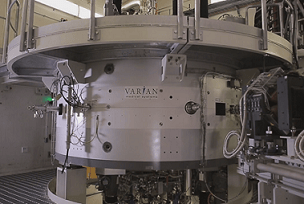Varian Medical Systems (VAR.NYSE) announced that the South Florida Proton Therapy Institute (SFPTI) has treated its first patient using the Varian ProBeam Compact single-room proton therapy system.
Face it. There’s a strong chance that you’re going to contract some variety of cancer in your lifetime.
Here are some hard stats for 2019:
- 113,000 Canadian men will be diagnosed with cancer and 43,300 men will die.
- 107,400 Canadian women will be diagnosed with cancer and 38,700 women will die.
- On average, 604 Canadians will be diagnosed with cancer every day.
- On average, 225 Canadians will die from cancer every day.
Everyone’s life has been touched by cancer in some way. Be it a direct relative or a friend. Nobody is immune and nobody gets away unscathed. The existing treatments we have for various types of cancers are expensive both financially, and in terms of health demands.
Proton therapy uses protons, accelerated to about two-thirds the speed of light, or more than 100,000 miles per second, to destroy cancer cells, while minimizing exposure to nearby healthy tissues.
“Proton therapy is the latest and by far the most advanced radiation treatment available, and at SFPTI we use these highly precise particle beams instead of traditional x-rays to treat tumors more precisely, with much less exposure to the surrounding normal tissues. Proton therapy can be used to treat children with cancer as well as adult tumors of the brain, spine, head and neck, lung, prostate, GI tract, and breast tumors. I am truly grateful to finally be able to make this long-standing vision of bringing this world-class technology to south Florida a reality,” said Tim Williams medical director, SFPTI.
Controversy
Proton beam therapy has been around since 1954, when it was first introduced at the Berkeley Radiation Laboratory. It has since treated more than 100,000 patients worldwide. Interest in the technology has only spiked in recent years.
The therapy requires the use of a particle accelerator called either a cyclotron or synchrotron—a 220 ton machine similar size to an SUV and weights as much as a Boeing 747. It uses high powered magnets to strip protons from hydrogen atoms in water and accelerate them. After which, the protons are directed into a beamline—an airless tube about the size of a football field—and into devices that otherwise blast the desired radiation into a tumour.

If you’re wondering what something like that must cost, then you’re not alone.
The University of Pennsylvania hefted a $144 million price stag to open its centre in 2010, while the Hampton University Proton Therapy Institute in Virginia opened theirs a few months later for $225 million. The problem here isn’t the operational price point—if technology is effective, then no price would be enough—it’s that the jury’s out as to efficacy of proton beam therapy when placed against other (cheaper) forms of radiation. It ultimately leads to the question of whether or not the oncology community has jumped to conclusions, favouring an expensive, unproven treatment over alternatives that cost half as much.
“There’s a group that believes proton therapy is the be-all and end-all of cancer treatment, and there are those who are more skeptical,” Adam P. Dicker, MD, PhD, director of the Christine Baxter Research Laboratory for Experimental Cancer Therapeutics.
Proton therapy is far from cheap, but it carries fewer side-effects than chemotherapy and radiation therapy:
In general, common side effects of proton therapy include:
- Fatigue
- Mouth, eating and digestion problems
- Headaches
- Hair loss around the part of your body being treated
- Skin redness around the part of your body being treated
- Soreness around the part of your body being treated
Proton therapy is used as a treatment for both cancer and some noncancerous tumors. Proton therapy can be used alone or in conjunction with other treatments, like surgery or chemotherapy.
Here’s a YouTube clip giving some of the science in detail.
—Joseph Morton

